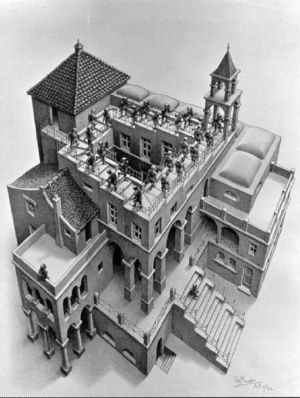Difference between revisions of "Descend"
| Line 1: | Line 1: | ||
[[Image:lighterstill.jpg]] | [[Image:lighterstill.jpg]] | ||
| − | + | [[Image:Ascending_and_Descending.jpg|right|frame]] | |
==Etymology== | ==Etymology== | ||
'''descend''' | '''descend''' | ||
| Line 9: | Line 9: | ||
==Wikipedia== | ==Wikipedia== | ||
| − | |||
'''''Ascending and Descending''''' is a [[Lithography|lithograph]] print by the [[Netherlands|Dutch]] artist [[M. C. Escher]] which was first printed in March [[1960]]. | '''''Ascending and Descending''''' is a [[Lithography|lithograph]] print by the [[Netherlands|Dutch]] artist [[M. C. Escher]] which was first printed in March [[1960]]. | ||
Revision as of 20:26, 8 November 2008
Etymology
descend
c.1300, from O.Fr. descendre, from L. descendere, from de- "down" + scandere "to climb," from PIE base *skand- "jump." Sense of "originate from" is c.1375. Descent is attested from c.1330; descendant "offspring" is from 1600.
Online Etymology Dictionary, © 2001 Douglas Harper
Wikipedia
Ascending and Descending is a lithograph print by the Dutch artist M. C. Escher which was first printed in March 1960.
The original print measures 14" x 11 1/4”. The lithograph depicts a large building roofed by a never-ending staircase. Two lines of identically dressed men appear on the staircase, one line ascending whilst the other descends. Two figures sit apart from the people on the endless staircase: one in a secluded courtyard, the other on a lower set of stairs. While most two-dimensional artists use relative proportions to create an illusion of depth, Escher here and elsewhere uses conflicting proportions to create the visual paradox.
Ascending and Descending was influenced by, and is an artistic implementation of, the Penrose stairs, an impossible object; Lionel Penrose had first published his concept in the February, 1958 issue of the British Journal of Psychology. Escher developed the theme further in his print Waterfall, which appeared in 1961.
References in popular culture
- In the game Gauntlet: Dark Legacy, the final level of the Dream Realm, known as the "Maze of Illusion", has an impossible staircase near the beginning, similar to this lithograph.
- In the French comic Game Over (spin off of Kid Paddle), the hero follows a staircase which appears similar to the staircase in this lithograph.
- In a Xiaolin Showdown, Omi and Dashi run up the everlasting staircase.
- In the movie, The Avengers, there is an impossible staircase.
- In the Nintendo 64 game Super Mario 64, an impossible staircase is featured towards the final stage.
- Ascending and Descending A wonderful 3D forced perspective model was build as part of a kit building contest
Sources
- Locher, J.L. (2000). The Magic of M. C. Escher. ISBN 0-8109-6720-0.
